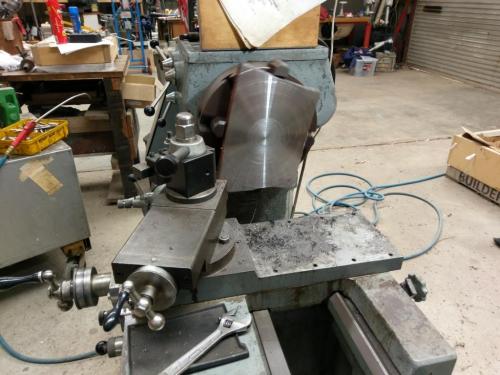02-09-2019, 07:19 AM
A little more progress...
I machined the ends of the top plate parallel with the top edge of the cheek plates, then indicated the vice to the Y-axis of the mill and machined the front faces of the cheek plates and top plate.
The two recesses machined into the cheek plates can be seen in the first two photos. I didn't like the large radius of the insert end-mill in the previous post, so I refinished them with a 12mm HSS end mill, this is a better fit for the DRO bracket. I'll make a similar bracket and arm to mount the MachTach display and probably VFD controls on the side opposite the DRO.




I machined the two sides of the 1.25" thick front plate by chucking it in the lathe and facing both sides.

I milled the two long sides parallel, the shorter of these sides was cut with the oxy and it milled just fine so my fears of hardening the edges with the oxy cut thankfully didn't happen. Blurry photo below shows the front plate propped in position on some parallels that are clamped to the underside of the overarm. It needs to be dowelled and bolted to the front edges of the three other plates.

Machining the two remaining oxy-cut sides of the front plate promises to be a pain, haven't figured out exactly how I'll attack that yet.
I machined the ends of the top plate parallel with the top edge of the cheek plates, then indicated the vice to the Y-axis of the mill and machined the front faces of the cheek plates and top plate.
The two recesses machined into the cheek plates can be seen in the first two photos. I didn't like the large radius of the insert end-mill in the previous post, so I refinished them with a 12mm HSS end mill, this is a better fit for the DRO bracket. I'll make a similar bracket and arm to mount the MachTach display and probably VFD controls on the side opposite the DRO.
I machined the two sides of the 1.25" thick front plate by chucking it in the lathe and facing both sides.
I milled the two long sides parallel, the shorter of these sides was cut with the oxy and it milled just fine so my fears of hardening the edges with the oxy cut thankfully didn't happen. Blurry photo below shows the front plate propped in position on some parallels that are clamped to the underside of the overarm. It needs to be dowelled and bolted to the front edges of the three other plates.
Machining the two remaining oxy-cut sides of the front plate promises to be a pain, haven't figured out exactly how I'll attack that yet.
Lathe (n); a machine tool used in the production of milling machine components.
Milling Machine (n); a machine tool used in the production of lathe components.
Milling Machine (n); a machine tool used in the production of lathe components.






![[Image: TomsTechLogo-Profile.png]](http://tomstechniques.com/wp-content/uploads/2013/11/TomsTechLogo-Profile.png)
 That way you could easily move the overarm.
That way you could easily move the overarm.
